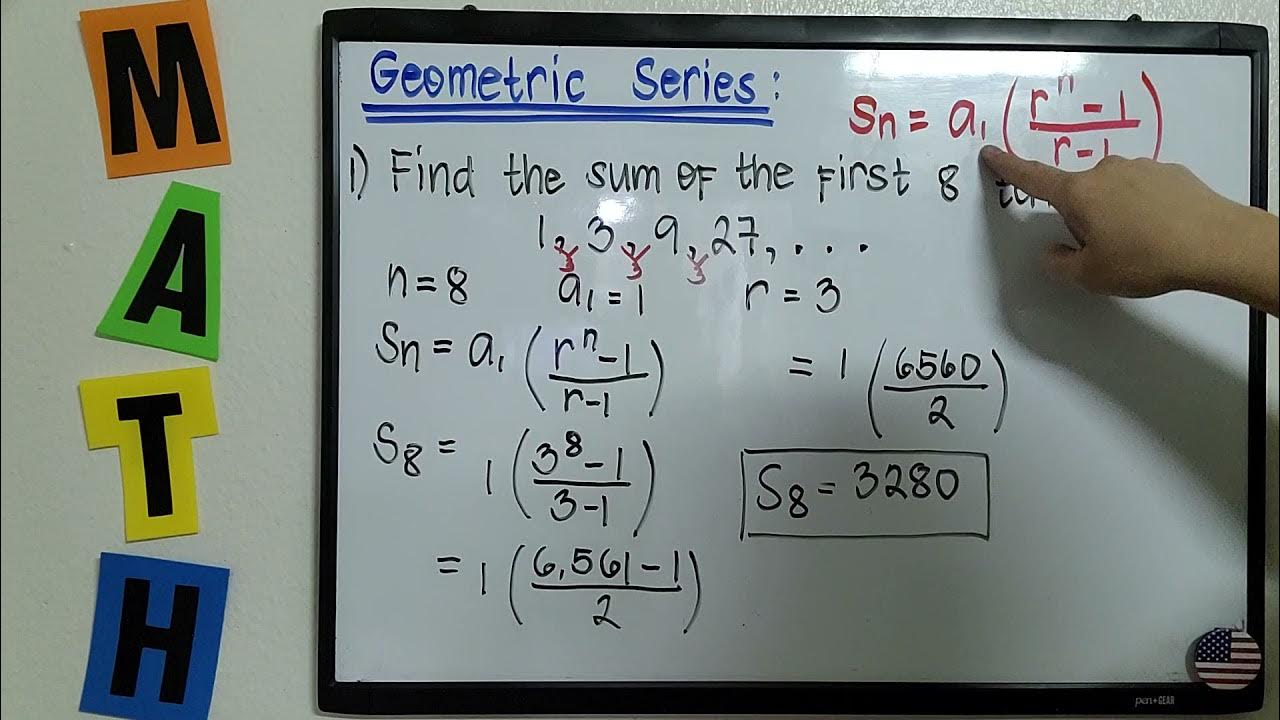Menemukan rumus jumlah Deret Geometri
Summary
TLDRIn this educational video, the teacher explains how to derive the formula for the sum of the first 'n' terms of a geometric sequence. The video covers the fundamental concept of geometric sequences, where each term is multiplied by a constant ratio. By manipulating the sequence and applying exponent rules, the teacher demonstrates how to derive the formula for both cases: when the ratio 'r' is less than 1, and when it's greater than 1. The lesson concludes with the formula for the sum of terms and encourages viewers to apply the concept in their studies.
Takeaways
- 😀 Geometric sequences involve a constant ratio between consecutive terms.
- 😀 The formula for the sum of the first 'n' terms of a geometric sequence is denoted as SN.
- 😀 The nth term of a geometric sequence can be written as Un = Ar^(n-1), where 'A' is the first term and 'r' is the common ratio.
- 😀 By multiplying each term in the sum by 'r', we can manipulate the sequence to simplify the calculation.
- 😀 Using the multiplication of exponents rule, the expression Ar^(n-1) * r becomes Ar^n.
- 😀 The sequence is formed by terms like A, Ar, Ar^2, Ar^3, and so on, with exponents decreasing.
- 😀 Subtracting the shifted sequence from the original helps to eliminate terms and simplify the sum.
- 😀 After subtracting, we find that SN - rSN = A - Ar^n, leading to a simplification.
- 😀 The formula for the sum of the first 'n' terms in a geometric sequence (when r < 1) is SN = A(1 - r^n) / (1 - r).
- 😀 When the common ratio (r) is greater than 1, the formula for SN becomes SN = A(r^n - 1) / (r - 1).
Q & A
What is a geometric sequence?
-A geometric sequence is a sequence of numbers where the ratio between consecutive terms is always constant or the same.
What does the formula SN represent in the context of a geometric sequence?
-The formula SN represents the sum of the first 'n' terms of a geometric sequence.
How is the general term of a geometric sequence represented?
-The general term of a geometric sequence is represented by the formula UN = Ar^(n-1), where 'A' is the first term and 'r' is the common ratio.
How do you obtain the formula for the sum of the first n terms of a geometric sequence?
-To find the formula, we multiply the sum of the sequence (SN) by the common ratio 'r' and subtract the resulting equation from the original sum, then solve for SN.
Why do we subtract the equation after multiplying by 'r'?
-We subtract the equation to eliminate terms that are common to both sides, simplifying the calculation and allowing us to isolate SN.
What happens when we subtract the equations, SN and r * SN?
-When we subtract, most terms cancel out, and we are left with a simplified expression involving only the first term and the last term in the sequence.
What does the formula SN = a(1 - r^n) / (1 - r) represent?
-This formula calculates the sum of the first n terms of a geometric sequence where the common ratio 'r' is less than 1.
What happens if the common ratio 'r' is greater than 1?
-If the common ratio 'r' is greater than 1, the formula changes to SN = a(r^n - 1) / (r - 1) to correctly represent the sum.
Why is the formula SN = a(r^n - 1) / (r - 1) valid for r > 1?
-This formula is valid for r > 1 because it accounts for the increasing nature of the terms in the geometric sequence when the ratio is greater than 1.
What condition is necessary for the formula SN = a(1 - r^n) / (1 - r) to be valid?
-The formula is valid when the common ratio 'r' is less than 1.
Outlines

This section is available to paid users only. Please upgrade to access this part.
Upgrade NowMindmap

This section is available to paid users only. Please upgrade to access this part.
Upgrade NowKeywords

This section is available to paid users only. Please upgrade to access this part.
Upgrade NowHighlights

This section is available to paid users only. Please upgrade to access this part.
Upgrade NowTranscripts

This section is available to paid users only. Please upgrade to access this part.
Upgrade NowBrowse More Related Video

TAGALOG: Geometric Series #TeacherA #GurongPinoysaAmerika

Barisan dan Deret Bagian 4 - Deret Geometri Matematika Wajib Kelas 11

Barisan dan deret Geometri kelas 10

Pola Bilangan [Part 3] - Barisan dan Deret Geometri

Pola bilangan - part 3

Geometric Series | Finding the Sum of Geometric Sequence | Explain in Detailed |
5.0 / 5 (0 votes)